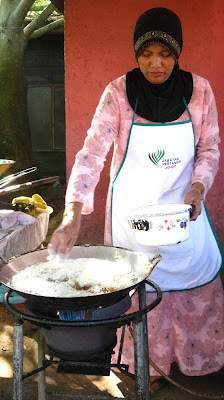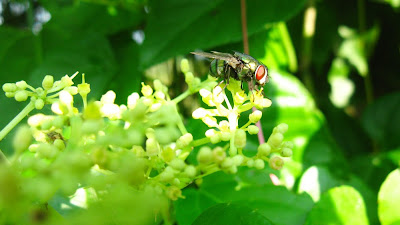Just over the weekend, I had the chance to go over to Malaysia for a "educational kampong tour" with my parents to Kluang, which is just above the Johor state. It was really quite educational and refreshing because this time, the guide was really quite knowledgeable about the stuff around.
Interestingly, the eco tourism, eco agricultural industry of Malaysia is rather well developed from the way my guide described it. They do have research farms to help cultivate strains of plants that will help farmers/ breed animals via artifical insemination to have animals that are better for consumption, and in addition, they do have tours for local children to farms.

There are rambutans growing at the farm. It was supposedly the durian season as well... but we didnt get to eat any durians.
The guide explaining the composition of the "medium" in which the mushrooms grow in. It's mainly made up of sawdust, slaked lime (to reduce neutralize the pH of the soil?), bran from rice (which is supposedly nutrient-rich). These things are taught to the poorer people in Malaysia so they are able to make a living. I guess such enterprises are pretty successful.

In the mushroom farm where they grow oyster mushrooms. These bags of opened-up mushrooms. Typically they are sealed till the mycelium of the fungi grows before the bags are opened up for the cap/stem of the mushroom to grow out. Oyster mushrooms do not require sunlight to grow and do not photosynthesize, hence they can be kept in this darkroom and still grow. These mushrooms absorb nutrients from the soil instead by spreading out their hypae and typically releasing enzymes.

These mushrooms are incubated before being put in the room above. Can't really remember the reason for the incubation though.

The lady cooking yummy fried mushrooms, not to eat too much though, it's ratherly unhealthy! :O Haha, anyway, I remember eating it in Taiwan as well, but the one here tastes better. The one in Taiwan was sprinkled with too much hot stuff!

Many many insects on this plant. Don't know it's name...

This is the plant that's shown above (zoomed-out view).

This plant (
Serai Wangi) acts as a natural mosquito-repellant. In fact, its smell reminds me of the repellant that I bought for Semakau trips! Haha. I think it's one of the ingredients used. Just to side track, it's fantastic, knowing that it deters lice as well (since the CTFS leaf litter picking intrudes into areas which have lice...)

Ladybird emerging after the short downpour.

The mulberry fruit. The fruits look like caterpillars! Haha.

Something interesting. It's the "dung discs" that help "digest" away clogged up drainage pipes/ rivers, according to the guide.

Dung discs from afar! They do have fungi growing all over it. These discs are typically thrown into the river. Initially, they were developed as sprays over waste rivers/waters but liquid substances sprayed over the river do not stay at one spot and are quickly washed away. Hence they created these dung discs that sink onto the bed of the river.

Plant that resembles a bird...

Cocoa/ palm oil. Cocoa, best known for cocoa butter and cocoa powder. The butter was really smooth... Palm oil is an important part of our daily lives. The other day, I just read about how impt it is to Singapore in particular. It can be used for cooking oil, beauty products, etc. I guess the whole palm oil trade industry is just quite complicated (biofuels/ deforestation etc).
The trip was quite cool. I learnt quite a bit. Kudos to the guide! :)
Reference:
http://www.borneofocus.com/saip/vaic/R&D/article2.htm
 In the mushroom farm where they grow oyster mushrooms. These bags of opened-up mushrooms. Typically they are sealed till the mycelium of the fungi grows before the bags are opened up for the cap/stem of the mushroom to grow out. Oyster mushrooms do not require sunlight to grow and do not photosynthesize, hence they can be kept in this darkroom and still grow. These mushrooms absorb nutrients from the soil instead by spreading out their hypae and typically releasing enzymes.
In the mushroom farm where they grow oyster mushrooms. These bags of opened-up mushrooms. Typically they are sealed till the mycelium of the fungi grows before the bags are opened up for the cap/stem of the mushroom to grow out. Oyster mushrooms do not require sunlight to grow and do not photosynthesize, hence they can be kept in this darkroom and still grow. These mushrooms absorb nutrients from the soil instead by spreading out their hypae and typically releasing enzymes. This plant (Serai Wangi) acts as a natural mosquito-repellant. In fact, its smell reminds me of the repellant that I bought for Semakau trips! Haha. I think it's one of the ingredients used. Just to side track, it's fantastic, knowing that it deters lice as well (since the CTFS leaf litter picking intrudes into areas which have lice...)
This plant (Serai Wangi) acts as a natural mosquito-repellant. In fact, its smell reminds me of the repellant that I bought for Semakau trips! Haha. I think it's one of the ingredients used. Just to side track, it's fantastic, knowing that it deters lice as well (since the CTFS leaf litter picking intrudes into areas which have lice...)
No comments:
Post a Comment